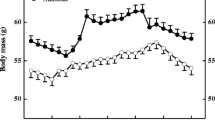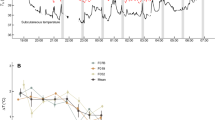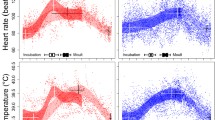Summary
The Goldcrest is an interesting species for studies of physiological and behavioural adaptions to cold, since it is the smallest species present in Europe. Although many small birds have to lower their metabolic rate and enter hypothermia in order to make their energy reserves last throughout the night, our measurements of oxygen consumption of five Goldcrests suggest that these birds may be able to balance their nocturnal energy budget during the winter at normothermic body temperatures, provided that the available food supply is adequate. These results are in agreement with those of another small bird, the Common Bushtit, which, like the Goldcrest, reduce nocturnal heat loss by contact roosting. Since the energy saved by hypothermia decreases with decreasing ambient temperature and also decreasing body weight, this strategy might not be such an advantage for the smallest birds living at very low ambient temperatures.
Zusammenfassung
Am Wintergoldhähnchen als dem kleinsten europäischen Vogel interessieren besonders seine physiologischen und Verhaltens-Anpassungen an niedere Temperaturen. Viele Kleinvögel senken ihre Stoffwechselaktivität und verfallen in Hypothermie, um mit ihren Energie-Reserven während der langen Winternächte auszukommen. Unsere Untersuchungen über den O2-Verbrauch von 5 Wintergoldhähnchen legen jedoch nahe, daß sich das nächtliche Energie-Budget auch im Tiefwinter auf Normalniveau bewegt und daß sie bei ausreichendem Nahrungsangebot ihre normale Körpertemperatur auch nachts beibehalten. Ähnliche Befunde liegen von den vergleichbaren kleinen amerikanischen Buschmeisen vor, die wie Goldhähnchen den nächtlichen Wärmeverlust durch Schlafen auf engem Gefiederkontakt reduzieren. Es ist anzunehmen, daß die Hypothermie als Überwinterungsstrategie für unsere kleinsten Vögel garnicht so vorteilhaft wäre: Die durch Hypothermie eingesparte Energie geht mit abnehmender Umgebungstemperatur und mit geringerer Körpergröße wieder verloren.
Similar content being viewed by others
Literature
Aschoff, J., &H. Pohl (1970): Der Ruheumsatz von Vögeln als Funktion der Tageszeit und der Körpergröße. J. Orn. 111: 38–47.
Blem, C. R., &J. F. Pagel (1984): Mid-winter lipid reserves of the Golden-crowned Kinglet. Condor 86: 491–492.
Chaplin, S. B. (1982): The energetic significance of huddling behaviour in Common Bushtits (Psaltriparus minimus). Auk. 99: 424–430.
Ditto,D. A. Diesel &J. A. Kasparie (1984): Body temperature regulation in Red-tailed Hawks and Great Horned Owls: responses to air temperature and food deprivation. Condor 86: 175–181.
Dixon, M. (1934): Manometric methods. Cambridge.
Gordon, M. S. (1982): Animal physiology; principles and adaptations. N. Y.
Grossman, A. F., &G. C. West (1977): Metabolic rate and temperature regulation of winter acclimatized Black-capped ChickadeesParus atricapillus of interior Alaska. Ornis Scand. 8: 127–138.
Hildén, O. (1982): Winter ecology and partial migration of the GoldcrestRegulus regulus in Finland. Ornis Fenn. 59: 99–122.
Hogstad, O. (1984): Variation in numbers, territoriality and flock size of a GoldcrestRegulus regulus population in winter. Ibis 120: 139–146.
Lagerström, M. (1979): Goldcrests (Regulus regulus) roosting in the snow. Ornis Fenn. 56: 170–171.
McNab, B. K. (1983): Energetics, body size and the limits to endothermy. J. Zool. Lond. 199. 1–29.
Reinertsen, R. E. (1982): Radio telemetry measurements of deep body temperature of small birds. Ornis Scand. 13: 11–16.
Ditto (1983): Nocturnal hypothermia and its energetic significance for small birds living in the arctic and subarctic regions. A review. Polar Res. 1: 269–284.
Ditto (1986): Hypothermia in northern passerine birds, pp. 419–426. In:H. C. Heller, X. J. Musacchia &L. C. H. Wang (eds.), Living in the cold: physiological and biochemical adaptations. N. Y.
Thaler, E. (1973): Zum Verhalten überwinternder Goldhähnchen (Regulus r. regulus (L.) in der Umgebung Innsbrucks (Nordtirol: Österreich). Ber. nat.-med. Ver. Innsbruck 60: 167–182.
Author information
Authors and Affiliations
Rights and permissions
About this article
Cite this article
Reinertsen, R.E., Haftorn, S. & Thaler, E. Is hypothermia necessary for the winter survival of the GoldcrestRegulus regulus?. J Ornithol 129, 433–437 (1988). https://doi.org/10.1007/BF01644486
Published:
Issue Date:
DOI: https://doi.org/10.1007/BF01644486




